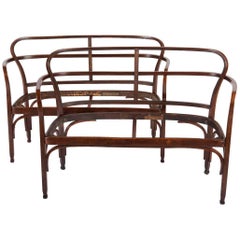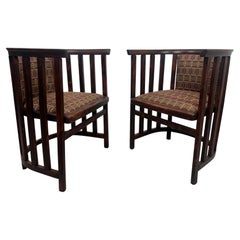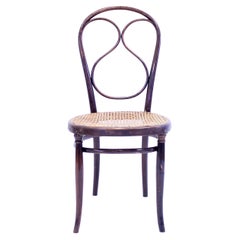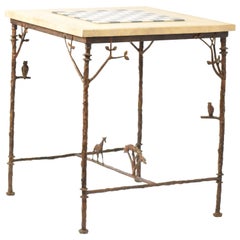Expressionist Furniture
to
269
861
648
1,296
210
110
199,419
114,643
43,305
33,290
16,274
12,153
10,768
10,596
9,916
8,994
7,287
6,748
6,520
6,484
6,161
5,761
4,942
3,794
1
84
1,211
320
601
272
226
254
125
57
24
23
26
38
42
32
32
638
499
322
266
251
972
559
319
294
156
1,616
1,541
1,559
123
88
77
44
32
Style: Expressionist
Vienna Secession J. J. Kohn 717 Settee by Gustav Siegel
Located in Vienna, AT
An exquisite and very seldom Vienna Secession bentwood settee by Gustav Siegel.
This settee is still not finished and will be restored to cu...
Category
Early 1900s Austrian Antique Expressionist Furniture
Materials
Beech, Bentwood
£3,764 Sale Price / item
27% Off
Bentwood Children Chair by Thonet
Located in Vienna, AT
Beech bentwood Thonet Nr. 1 first time mentioned in the catalogue from the 1880s. This one is from 1910s-1920s.
Chair is fully restored, walnut stained and shellack polished with ne...
Category
1910s Austrian Vintage Expressionist Furniture
Materials
Cane, Beech, Bentwood
£347 Sale Price
22% Off
Secession Fledermaus armchairs by Josef Hoffmann
Located in Banská Štiavnica, SK
Secession Fledermaus armchairs by Josef Hoffmann. Professionally stained and repolished with new fabric.
Category
1920s Austrian Vintage Expressionist Furniture
Materials
Fabric, Beech, Bentwood
£4,458 / set
Turkish Deco Animal Figurative Runner
Located in New York, NY
One-of-a-kind Turkish deco runner with a flurry of animals on a mint green field.
Measures: 2.10" x 8.11".
Category
1960s Turkish Vintage Expressionist Furniture
Materials
Wool
Fischel bentwood café chair, early 20thy century
By Fischel
Located in Uppsala, SE
Stunning bentwood chair manufactured by Fischel around turn of the century 1900. Fischel was one of the larges producer of bentwood furniture alongside Thonet and J&J Kohn. The backr...
Category
Early 20th Century Czech Expressionist Furniture
Materials
Beech
Chess Table in cast bronze with African theme
Located in Pretoria, Gauteng
Chess Table in cast bronze
Bespoke Table in cast Bronze inspired by Diego Giacometti with African theme with inset chess board made of sandstone and black slate. Table featuring a giraffe, acacia tree, hornbill, owl, leaves and twigs - all individually sculpted by hand and cast in Bronze. Excludes chess pieces. Table: Height 73cm, Length 80cm, Width 80cm
Combining art, design and functionality, all furniture and lighting...
Category
2010s South African Expressionist Furniture
Materials
Stone, Slate, Sandstone, Bronze
Expressionist Amsterdam School Reclining Chairs, Oak and Fabric Upholstery, 1920
Located in Berlin, DE
Pair of early Amsterdam School (1910-1930) reclining chairs manufactured c. 1920.
The exuberant appearance characteristic of the movement's first period features
strong sculptural expressionist lines with elaborate details different from one chair
to another and dynamic shape through the movement function. The reclining
backrest typical of the Arts and Crafts Morris chair...
Category
1920s Dutch Vintage Expressionist Furniture
Materials
Oak, Bentwood
Viennese Secessionist Rug Doris Leslie Blau
Located in New York, NY
Viennese Secessionist Rug
Size: 12'9" × 16'4" (388 × 497 cm)
This exquisite antique rug, sourced from Doris Leslie Blau, showcases a rare blend of history and craftsmanship. This ant...
Category
Early 20th Century Austrian Expressionist Furniture
Materials
Wool
Vienna Secessionist Marble, Copper and Brass Platter Tray
Located in Stamford, CT
Austrian Belgian black marble dish with a wonderful copper repousse band with decoration typical of the Vienna Secession, that evokes the background ...
Category
Early 20th Century Austrian Expressionist Furniture
Materials
Belgian Black Marble, Brass, Copper
Zabihi Collection Chinese Art Deco Rug
Located in New York, NY
an early 20th Century Chinese Art Deco Square Rug
8'1'' x 9'6''
Category
Early 20th Century Chinese Expressionist Furniture
Materials
Wool
Framed Nude Portrait Painting of a Man in Gilt Wood on Board Untitled
Located in Oklahoma City, OK
A framed portrait painting of a man in the nude on wood. With wonderful texture, and muted greens, beiges, and browns, this painting will be a...
Category
20th Century American Expressionist Furniture
Materials
Wire
£728 Sale Price
20% Off
Picasso School Painting of a Harlequin with Horses, Oil on Artist Cardboard
Located in Vero Beach, FL
This is a masterfully painted work in the style of Picasso’s Rose period. It leans on the famous painting, “Boy Leading a Horse”. Executed in oil on artis...
Category
Early 20th Century French Expressionist Furniture
Materials
Other
£2,414 Sale Price
40% Off
Chagall: Love and the Stage 1914-1922 Hardcover Book
Located in North Hollywood, CA
Chagall: Love and the Stage 1914-1922. large hardcover 1st edition 1998, out of print.
Marc Chagall, Royal Academy of Arts (Great Britain).
Merrell Holberton, 1998 - Art - 104 pages....
Category
Late 20th Century British Expressionist Furniture
Materials
Paper
1900s Viennese Secession Sofa in the Style of Josef Maria Olbrich
Located in Praha, CZ
- carefully refurbished -
- Professionally reupholstered in quality fabric designed by Gustav Klimt
- height of seat 45 cm.
Category
Early 1900s Austrian Antique Expressionist Furniture
Materials
Wood, Fabric
£2,068 Sale Price
20% Off
50th Anniversary NASCAR The Thunder of America 1988
Located in North Hollywood, CA
NASCAR: The Thunder of America.Thunder Of America: 50th Anniversary of NASCAR hardcover 1988.Published by Harper, 1988.200 pages of NASCAR history, info, stats and photos.Hardcover w...
Category
Late 20th Century French Expressionist Furniture
Materials
Paper
Pair of Art Nouveau Leather Club Chairs, circa 1920
Located in Lucenec, SK
A pair of rare Art Nouveau leather club chairs made in the early twentieth century probably in Austria. The chairs are in their original condition ...
Category
Early 20th Century Austrian Expressionist Furniture
Materials
Leather, Wood
£2,639 Sale Price / set
20% Off
Thonet office chair with rattan seat
By Thonet
Located in Banská Štiavnica, SK
Thonet office chair with rattan seat professionally stained and repolished, new handmade rattan seat.
Category
1910s Austrian Vintage Expressionist Furniture
Materials
Rattan, Beech
Viennese Secession Brass Mounted Hardwood Side Table, Austria C. 1920
Located in West Palm Beach, FL
Viennese secession brass mounted hardwood side table, Austria C. 1920
With oval brass mounted hardwood top, raised a four brass column pedestal base, w...
Category
1920s Austrian Vintage Expressionist Furniture
Materials
Brass
£1,791 Sale Price
20% Off
Otto Wagner Lamp "Die Zeit", Re-Edition
Located in Vienna, AT
Pendant lamp for the dispatch bureau of the daily newspaper "Die Zeit" in Vienna, Kaerntnerstrasse/Annagasse, 1902 designed by Otto Wagner. A reconstruction of the facade is exhibite...
Category
2010s Austrian Expressionist Furniture
Materials
Brass
£6,688 / item
Large Original Abstract Painting, Acrylic on Canvas, Signed
Located in Vero Beach, FL
"Twilight", 48 x 60”, depth 2”
Acrylic on canvas. Gallery wrapped.
Signed: Suzanne Clune NAWA
Created: 2018
Suzanne Clune was born in the Hudson Valley into a family of e...
Category
2010s American Expressionist Furniture
Materials
Canvas, Acrylic
Very rare secession seating group
By Otto Wagner
Located in Banská Štiavnica, SK
Very rare secession seating group used in Otto Wagners Vila in Wien. Original vintage condition with signs of use.
Category
Early 1900s Austrian Antique Expressionist Furniture
Materials
Wood
£53,506 / set
Modigliani & the Artists of Montparnasse
Located in Bradenton, FL
Modigliani & the Artists of Montparnasse. Softcover book, published in conjunction with the exhibition at the Albright-Knox Art Gallery, Buffalo, the Kimbell Art Museum, Fort Worth, ...
Category
21st Century and Contemporary Expressionist Furniture
Materials
Paper
Vase Amphora Austria Art Nouveau Bohemia Teplitz Ceramics Secessionist
Located in Bad Säckingen, DE
This large and unusual floral hand-decorated double-handled ceramic vase by Ampora Turn-Teplitz showcases the characteristic artistic sensibilities of the Art Nouveau Vienna Secessio...
Category
Early 1900s Austrian Antique Expressionist Furniture
Materials
Ceramic
£560 Sale Price
20% Off
New Moroccan Rug Inspired by Alberto Giacometti Dogon Tribe
Located in Dallas, TX
80530, new contemporary Moroccan rug inspired by Alberto Giacometti Dogon Tribe. This hand knotted wool contemporary Moroccan rug features elongated silhouettes in a dark pink-scale palette against a solid creamy-beige backdrop. With cool Jazz Age style and reminisce of Giacometti, this contemporary Moroccan rug evokes a musical oeuvre that'll make you sing the blues. The cream and dark pink figures wear shirts and pants with smart dress shoes or dresses with pumps. All the figures are tightly coiffed or wear their hair short. This unique carpet design draws its inspiration from a combination of the Dogon people, Alberto Giacometti (Swiss sculptor), and Étienne de Silhouette, a French finance...
Category
21st Century and Contemporary Pakistani Expressionist Furniture
Materials
Wool
£4,250 Sale Price
20% Off
Adolf Loos Style Six-Legged Table with Copper Plate
By Adolf Loos
Located in Banská Štiavnica, SK
Adolf Loos six-legged table with copper plate professionally stained and repolished.
Category
Early 1900s Austrian Antique Expressionist Furniture
Materials
Copper
Jacob & Josef Kohn Vienna Secession Patinated Chairs with Wicker Seats, Pair
Located in Barcelona, ES
Beautiful pair of bentwood chairs patinated in white color with cane weave seats. Manufactured by J & J Kohn. Austria, 1900s.
Both are marked with the original manufacturers paper l...
Category
Early 20th Century Austrian Expressionist Furniture
Materials
Bentwood, Cane, Wood
Lithograph "Abruzzo" by Michele Cascella 1960s
Located in Milano, MI
Lithograph titled "Abruzzo" by Michele Cascella, created in the 1960s.
Ø cm 38 h cm 29 including frame
Michele Cascella (Ortona, September 7, 1892 - Milan, August 31, 1989) was an ...
Category
1960s Italian Vintage Expressionist Furniture
Materials
Paper
Living with Art Fifth Edition Paperback 1998 by Rita Gilbert
Located in North Hollywood, CA
Living with Art is a basic art text for college students and other interested readers.
It offers a broad introduction to the nature, vocabulary, media and history of art, showing exa...
Category
Late 20th Century Expressionist Furniture
Materials
Paper
Vienna Secession Stool By Wilhelm Schmidt For Prag Rudnicker
Located in Vienna, AT
Oak frame with a caned seat, Designed by Vienna Secession designer Wilhelm Schmidt about 1900 for Prag-Rudniker Korbwaren-Fabrication. Fully restored but the seat is still the origin...
Category
Early 1900s Austrian Antique Expressionist Furniture
Materials
Brass
New Colorful Modern Berber Beni Mrirt Moroccan Carpet with Expressionist Style
Located in Dallas, TX
21102 Rare Colorful Beni Mrirt Abstract Moroccan Rug, 10'01 x 13'05. Prepare to step into a world where modern surrealism meets ancient symbolism—this hand-knotted wool modern abstra...
Category
21st Century and Contemporary Moroccan Expressionist Furniture
Materials
Wool
Patinated Brass Vienna Secession Magazine Rack
Located in Amsterdam, NL
Stunning and rare Vienna Secession magazine rack.
Striking Austrian design from the 1900s.
Patinated brass frame with decorative elements.
This wonderful Vienna Secession magazine ra...
Category
Early 1900s Austrian Antique Expressionist Furniture
Materials
Brass
£606 Sale Price
20% Off
Clara Porset Style Sling Chair
By Clara Porset
Located in Brooklyn, NY
A mid-century sling chair with a black lacquered base and newly upholstered leather seat in the style of the trailblazing Cuban-born furniture and interior designer Clara Porset.
Category
Mid-20th Century Unknown Expressionist Furniture
Materials
Leather, Wood, Lacquer
Otto Wagner Jugendstil "Viennese Tramway" Wall or Ceiling Lights, 3 Available
By Otto Wagner
Located in North Miami, FL
These vintage and all original medium sized lights have been rewired for USA. Wall or ceiling light with opaline glass, pictured in brass, designed for the Viennese trams. We are sel...
Category
1910s Austrian Vintage Expressionist Furniture
Materials
Brass
20th Paris School Collage Cutout Artwork Wonderful Interior Design Options
Located in Cirencester, GB
"Collage"
by Bernard Herzog (French, b.1935).
signed and stamped verso with catalogue number.
photo collage cut outs on paper, unframed.
Overall paper: 25.5 x 20 inches
Highly uniq...
Category
Mid-20th Century Expressionist Furniture
Materials
Other
Austrian Hoffman Bentwood Secessionist Table Desk
Located in Queens, NY
Austrian Bentwood Secessionist (19/20th Century) table desk with spindle gallery & 3 drawers and brown leather top (attributed to: HOFFMAN)
Category
19th Century Austrian Antique Expressionist Furniture
Materials
Bentwood
Secession Plant Table No.38 Otto Wagner for Thonet
By Thonet, Otto Wagner
Located in Banská Štiavnica, SK
Secession plant table no.38 Otto Wagner for Thonet professionally stained and repolished.
Category
Early 1900s Czech Antique Expressionist Furniture
Materials
Bentwood
Secession Side Table
Located in Banská Štiavnica, SK
Art Nouveau Side table mahogany and beech wood combined with brass in Vienna secession style. Professionally stained and repolished.
Category
1910s Austrian Vintage Expressionist Furniture
Materials
Brass
Beech Vienna Secession Art Nouveau Console Table by Jacob & Josef Kohn, 1900s
Located in Amsterdam, NL
Stunning and rare Vienna Secession Art Nouveau console table.
Design by Jacob & Josef Kohn.
Striking Austrian design from the 1900s.
Original lacquered beech base with original la...
Category
Early 1900s Austrian Antique Expressionist Furniture
Materials
Beech
£1,177 Sale Price
20% Off
Red Otis Huband Abstract Painting
Located in Houston, TX
Otis Huband is an American artist known for his vibrant and abstract paintings. His work is characterized by a bold use of color, dynamic compositions, and a distinct sense of rhythm...
Category
21st Century and Contemporary American Expressionist Furniture
Materials
Canvas, Paint
Antique Austrian Savonnerie Arts and Crafts Viennese Secession Rug c. 1890s
Located in New York, NY
This a rare and pristine Antique Austrian Savonnerie Arts and Crafts Viennese Secession Rug in jewel tones dating back to c. 1890.
It measures 5 x 8.6 ft with full pile.
Complimen...
Category
1890s Austrian Antique Expressionist Furniture
Materials
Wool
Zabihi Collection Silk Chinese Red Pictorial Rug
Located in New York, NY
A Chinese silk pictorial rug. On a border-less burgundy red ground, 11 Immortals stand on clouds .Each immortal has its own unique colorful outfit o...
Category
Early 20th Century Chinese Expressionist Furniture
Materials
Silk, Wool
Graciela Rodo Boulanger Peacock For Sophie Signed and Numbered Lithograph 1979
Located in North Hollywood, CA
Graciela Rodo Boulanger " Peacock For Sophie" Pencil Signed and Numbered Lithograph 1979.
GRACIELA RODO BOULANGER (Bolivia born 1935).
Child in a tree with a peacock below.
Pencil si...
Category
Late 20th Century French Expressionist Furniture
Materials
Wood
Antique Framed Oil Painting on Canvas signed Rainbo
Located in Dallas, TX
Antique Framed Oil Painting on Canvas signed Rainbo depicts the interior of a cathedral, most likely the most prominent church in the city. The artist has used a superb sense of per...
Category
Mid-20th Century Belgian Expressionist Furniture
Materials
Canvas, Wood, Paint
New Modern Abstract Beni Mrirt Moroccan Rug, Berber Tribes of Morocco
Located in Dallas, TX
21649 New Modern Abstract Beni Mrirt Moroccan Rug, 10'00 x 13'00. Immerse yourself in a world where fine art and ancestral craftsmanship converge—this hand-knotted modern abstract Be...
Category
21st Century and Contemporary Moroccan Expressionist Furniture
Materials
Wool
Secession dining chairs no.413 by Josef Hoffmann for Thonet
By Thonet, Josef Hoffmann
Located in Banská Štiavnica, SK
Secession dining chairs no.413 by Josef Hoffmann for Thonet Debrecen in very nice original condition.
Category
1910s Hungarian Vintage Expressionist Furniture
Materials
Beech, Bentwood
Wall shelf by Koloman Moser for Wiener Werkstätte
Located in Banská Štiavnica, SK
Wall shelf by Koloman Moser for Wiener Werkstätte in very good original condition.
Category
Early 1900s Austrian Antique Expressionist Furniture
Materials
Wood
Rare Viennese Rug Doris Leslie Blau
Located in New York, NY
Rare Viennese Rug Doris Leslie Blau
Size: 12'8" × 15'10" (386 × 482 cm)
Circa: 1900
Age: Vintage
Color: Beige, Green
Type: Viennese
Style: Art Deco
Origin: Europe
This vintage Vienne...
Category
Early 20th Century Austrian Expressionist Furniture
Materials
Wool
Thonet Rocking Chair, Model Number 511, Vienna Secession, circa 1904
Located in Buenos Aires, Buenos Aires
Thonet rocking chair, model number 511. Vienna Secession, circa 1904.
Category
Early 1900s Austrian Antique Expressionist Furniture
Materials
Beech, Rattan, Bentwood
Rare Viennese Secession Brass Plant Stand with Marble Top Koloman Moser Style
Located in Lisse, NL
Modernist display stand from the turn of the century.
This brass Viennese Secession plant stand is in the style of Koloman Moser and it is a beautiful and timeless design. The marb...
Category
Early 20th Century European Expressionist Furniture
Materials
Marble, Brass
'Chucho' Reyes Signed Gouache of a Horse on Mounted Paper
Located in Sharon, CT
Jesus 'Chucho' Reyes Ferrera gouache painting on his typical medium -tracing paper, which has been mounted to a thin board (which has cracked down the vertical center).
Category
Mid-20th Century Mexican Expressionist Furniture
Materials
Paper
Austrian Bentwood 'Secessionist' Beechwood Loveseat
Located in Queens, NY
Austrian bentwood 'Secessionist' beechwood loveseat with slat design and upholstered seat and back (J&J KOHN paper label under seat).
Jacob & Jos...
Category
20th Century Austrian Expressionist Furniture
Materials
Upholstery, Beech
Fledermaus Seating Group by Josef Hoffmann Ex. by Wittmann Wien
Located in Banská Štiavnica, SK
Fledermaus seating group by Josef Hoffmann ex. by Wittmann Wien circa 1950. Original vintage condition with signs of use. Sofa: wxdxh 119x50x74 seat height 44cm Armchair: wxdxh 56x50...
Category
1950s Slovak Vintage Expressionist Furniture
Materials
Beech
Stylish Blackened Wooden and Brass Art Deco Desk or Piano Swivel Stool, ca 1900
Located in Lisse, NL
Rare stool in the Viennese Secession style.
This fine, rare and elegant wooden swivel stool from the early 1900s was hand-crafted in Austria and it is perfect for sitting behind a...
Category
Early 20th Century Austrian Expressionist Furniture
Materials
Brass, Iron
An abstract expressionist painting by Bernard Segal, mid 20th century
Located in View Park, CA
An original abstract expressionist work on paper by Bernard Segal (1907-1986), New York mid 20th century. In predominant tones of magenta, licorice, and grenadine and with slight tou...
Category
Mid-20th Century American Expressionist Furniture
Materials
Wood, Paint, Paper
Bjorn Wiinblad ALADIN in the Enchanted Garden Porcelain Plate by Rosenthal
Located in North Hollywood, CA
Bjørn Wiinblad wall Plate, produced by Rosenthal.
ALADIN in the Enchanted Garden #4 Wall Plate Bjorn Wiinblad Rosenthal.
Vintage porcelain collector plate by Rosenthal Studio Line, Germany from the series " Aladin im Zubergarten" plate "Aladin und die Wunderlampe IV".
This decorative wall plate is titled "Aladin im Zaubergarten eingesperrt" (Aladin in the Enchanted Garden) and is number 4 in the collectible series of 12.
The plate includes hanging hardware affixed to the back, shown.
The various colors, together with the gold, make these plates true and precious collector's items.
Bjørn Wiinblad porcelain Rosenthal Studio Line Collectable Plate.
In pristine condition.
Dimensions: 6.25 in. diameter.
Artist: Bjørn Wiinblad.
Plate Number: 4 (series of 12)
Title: Aladin in the Enchanted Garden
Hardware: Fixed, hanging.
Aladdin and the Magic Lamp series was designed in the 60s by the Danish artist and chief designer of Rosenthal, Björn Wiinblad.
Connoisseurs of Wiinblad's work know that this great artist worked in various industries and fields in the 20th century and had his works in renowned museums such as the Victoria and Albert Museum in London, the Museum of Modern Art in New York, the National Museum in Sweden, were collected from the Moderna Museet in Copenhagen and today have a high collector's value.
Rosenthal is a German company that is well-known for its production of high-quality porcelain and other luxury goods. The company has a long history, dating back to the late 19th century, and it has collaborated with various artists and designers over the years to create unique and artistic pieces.
This Bjorn Wiinblad Vintage Danish Modern Rosenthal porcelain " Aladdin " collector's decorative plate is a very special and unique piece to add to your collection.
The porcelain collector's decorative wall plate is made by Rosenthal Studio Line, Germany from 1976 - 1982. Made of fine porcelain, the round decorative plate features a beautiful multicolor design of Aladdin with special metallic gold details. It is signed in the plate lower front and has an attached hanger on the reverse back side for easy wall installation.
Characteristics of Wiinblad's work include whimsical round faced people, dressed vaguely in 19th Century costume. They are often surrounded by natural elements : twining vines, floral wreathes, and fantastical trees. When Wiinblad employed color, he did so with great assurance. His color palette is saturated and strong, often accented with metallic gold or silver.
Bjørn Wiinblad was a Danish painter, designer, and artist known for his distinctive and whimsical style. He gained international recognition for his work, which often featured imaginative and decorative elements. Wiinblad was active from the mid-20th century until his passing in 2006.
Bjorn Wiinblad ( 1918 - 2006 ) was a Danish painter, designer, and artist known for his distinctive and whimsical style in ceramics, silver, bronze, textiles, and graphics. He gained international recognition for his work, which often featured imaginative and decorative elements.
His artworks have been exhibited internationally since the early 1950's. Wiinblad was named Man...
Category
Mid-20th Century German Expressionist Furniture
Materials
Porcelain
Biomorphic XL, Oversized Pair of Table Lamps, Black Resin, In-Stock
By Studio Chora
Located in Albuquerque, NM
Designed by Studio Chora, 2024.
Biomorphic: ‘bios' meaning life and 'morphe' meaning form.
Sold as a pair. The Biomorphic series of organic light sculptures are one-of-a-kind a...
Category
2010s American Expressionist Furniture
Materials
Cement, Limestone
20th Century Abstact Oil Painting by Peter Robert Keil, Germany
By Peter Keil
Located in Berghuelen, DE
20th Century Abstact Oil Painting by Peter Robert Keil, Germany
A vintage oilpainting painted by Peter Robert Keil in the late 20th century. The painting depicts a colorful, abstrac...
Category
Late 20th Century German Expressionist Furniture
Materials
Wood, Paint
Kohn Chair restored
Located in Vienna, AT
Wood is already restored, the chairs get now a new cane.
delivery time about two weeks
2 pieces available
Category
Early 20th Century Austrian Expressionist Furniture
Materials
Beech, Bentwood
£718 / item
Set of Four Bentwood Dining Chairs Attributed to Thonet
By Thonet
Located in Vienna, AT
Bentwood chairs as Thonet No 20. New canning on all chairs.
Four pieces available
Delivery time 3-4 weeks.
Category
Early 1900s Czech Antique Expressionist Furniture
Materials
Cane, Beech, Bentwood
Umbrella stand attributed to Josef Hoffmann - Kolo Moser
Located in Banská Štiavnica, SK
Umbrella stand attributed to Josef Hoffmann - Kolo Moser in very good original condition.
Category
1910s Austrian Vintage Expressionist Furniture
Materials
Metal, Brass
Expressionist furniture for sale on 1stDibs.
Find a broad range of unique Expressionist furniture for sale on 1stDibs. Many of these items were first offered in the 21st Century and Contemporary, but contemporary artisans have continued to produce works inspired by this style. If you’re looking to add vintage furniture created in this style to your space, the works available on 1stDibs include wall decorations, seating, rugs and carpets and other home furnishings, frequently crafted with wood, fabric and other materials. If you’re shopping for used Expressionist furniture made in a specific country, there are Europe, Austria, and North America pieces for sale on 1stDibs. While there are many designers and brands associated with original furniture, popular names associated with this style include Thonet, Jacob and Josef Kohn, Josef Hoffmann, and Berber Tribes of Morocco. It’s true that these talented designers have at times inspired knockoffs, but our experienced specialists have partnered with only top vetted sellers to offer authentic pieces that come with a buyer protection guarantee. Prices for furniture differ depending upon multiple factors, including designer, materials, construction methods, condition and provenance. On 1stDibs, the price for these items starts at $29 and tops out at $130,851 while the average work can sell for $2,718.
Recently Viewed
View AllMore Ways To Browse
Iron Cross
Japanese Step
Indian Painted Wood
Inlaid Wood Frame
Irish Gold
Japan Antiques Collectables
Large Wood Columns
Large Copper Plate
Italian Mid Century Textiles
Italian Glass Fish
Italian Mid Century Vanity
Irish Carved Furniture
Latin American Furniture
Green Vanity
Imperial Mid
Hand Woven Mat
Large Tassels
Hand Painted Hand Fans





